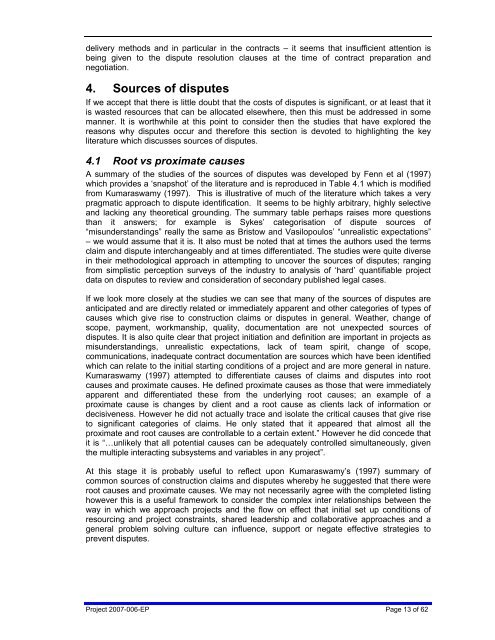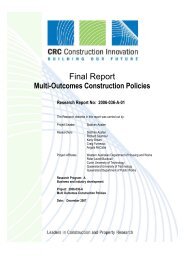Dispute Avoidance and Resolution (literature review) - Construction ...
Dispute Avoidance and Resolution (literature review) - Construction ...
Dispute Avoidance and Resolution (literature review) - Construction ...
You also want an ePaper? Increase the reach of your titles
YUMPU automatically turns print PDFs into web optimized ePapers that Google loves.
delivery methods <strong>and</strong> in particular in the contracts – it seems that insufficient attention isbeing given to the dispute resolution clauses at the time of contract preparation <strong>and</strong>negotiation.4. Sources of disputesIf we accept that there is little doubt that the costs of disputes is significant, or at least that itis wasted resources that can be allocated elsewhere, then this must be addressed in somemanner. It is worthwhile at this point to consider then the studies that have explored thereasons why disputes occur <strong>and</strong> therefore this section is devoted to highlighting the key<strong>literature</strong> which discusses sources of disputes.4.1 Root vs proximate causesA summary of the studies of the sources of disputes was developed by Fenn et al (1997)which provides a ‘snapshot’ of the <strong>literature</strong> <strong>and</strong> is reproduced in Table 4.1 which is modifiedfrom Kumaraswamy (1997). This is illustrative of much of the <strong>literature</strong> which takes a verypragmatic approach to dispute identification. It seems to be highly arbitrary, highly selective<strong>and</strong> lacking any theoretical grounding. The summary table perhaps raises more questionsthan it answers; for example is Sykes’ categorisation of dispute sources of“misunderst<strong>and</strong>ings” really the same as Bristow <strong>and</strong> Vasilopoulos’ “unrealistic expectations”– we would assume that it is. It also must be noted that at times the authors used the termsclaim <strong>and</strong> dispute interchangeably <strong>and</strong> at times differentiated. The studies were quite diversein their methodological approach in attempting to uncover the sources of disputes; rangingfrom simplistic perception surveys of the industry to analysis of ‘hard’ quantifiable projectdata on disputes to <strong>review</strong> <strong>and</strong> consideration of secondary published legal cases.If we look more closely at the studies we can see that many of the sources of disputes areanticipated <strong>and</strong> are directly related or immediately apparent <strong>and</strong> other categories of types ofcauses which give rise to construction claims or disputes in general. Weather, change ofscope, payment, workmanship, quality, documentation are not unexpected sources ofdisputes. It is also quite clear that project initiation <strong>and</strong> definition are important in projects asmisunderst<strong>and</strong>ings, unrealistic expectations, lack of team spirit, change of scope,communications, inadequate contract documentation are sources which have been identifiedwhich can relate to the initial starting conditions of a project <strong>and</strong> are more general in nature.Kumaraswamy (1997) attempted to differentiate causes of claims <strong>and</strong> disputes into rootcauses <strong>and</strong> proximate causes. He defined proximate causes as those that were immediatelyapparent <strong>and</strong> differentiated these from the underlying root causes; an example of aproximate cause is changes by client <strong>and</strong> a root cause as clients lack of information ordecisiveness. However he did not actually trace <strong>and</strong> isolate the critical causes that give riseto significant categories of claims. He only stated that it appeared that almost all theproximate <strong>and</strong> root causes are controllable to a certain extent.” However he did concede thatit is “…unlikely that all potential causes can be adequately controlled simultaneously, giventhe multiple interacting subsystems <strong>and</strong> variables in any project”.At this stage it is probably useful to reflect upon Kumaraswamy’s (1997) summary ofcommon sources of construction claims <strong>and</strong> disputes whereby he suggested that there wereroot causes <strong>and</strong> proximate causes. We may not necessarily agree with the completed listinghowever this is a useful framework to consider the complex inter relationships between theway in which we approach projects <strong>and</strong> the flow on effect that initial set up conditions ofresourcing <strong>and</strong> project constraints, shared leadership <strong>and</strong> collaborative approaches <strong>and</strong> ageneral problem solving culture can influence, support or negate effective strategies toprevent disputes.Project 2007-006-EP Page 13 of 62
















